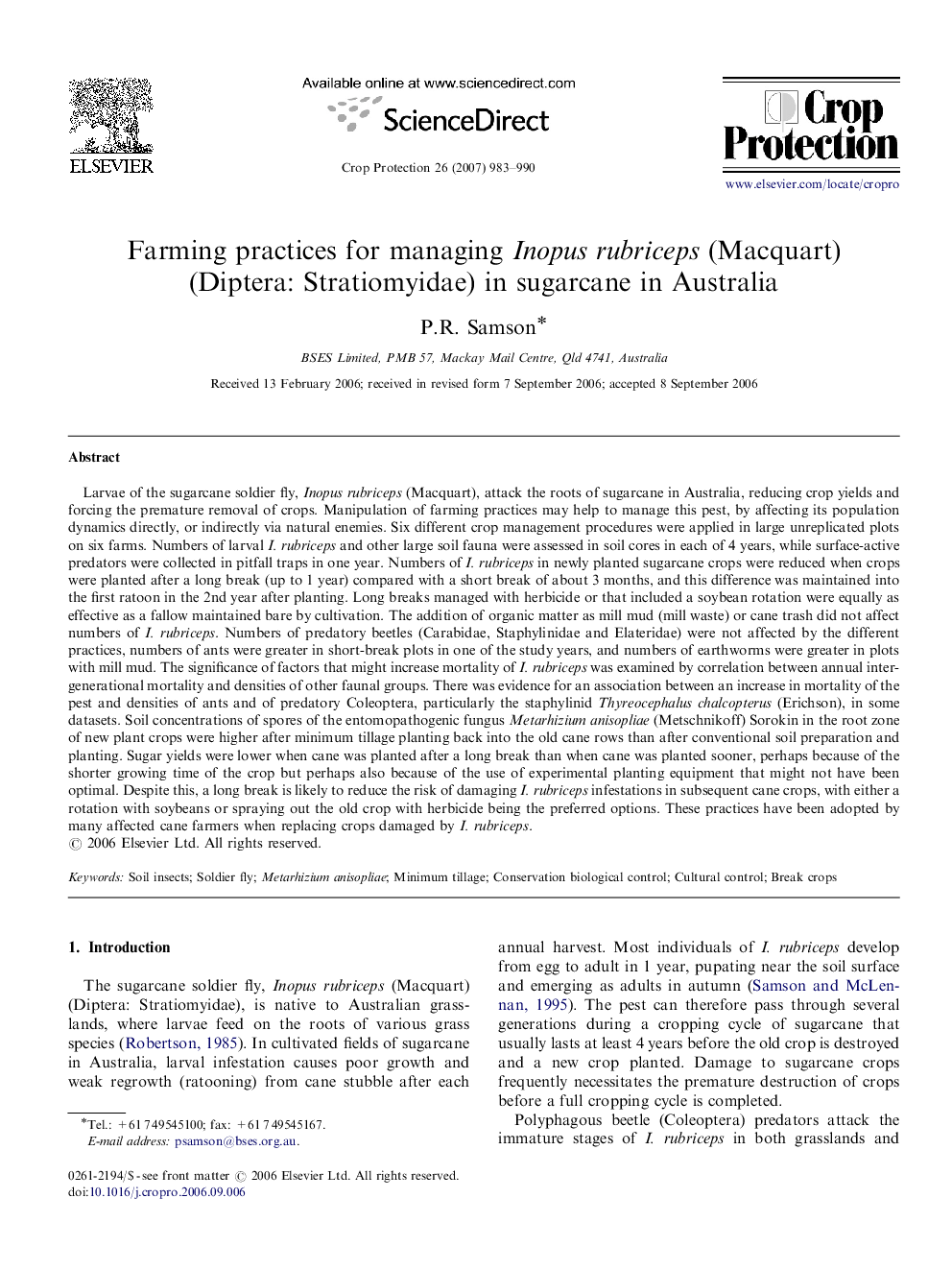| کد مقاله | کد نشریه | سال انتشار | مقاله انگلیسی | نسخه تمام متن |
|---|---|---|---|---|
| 4507846 | 1321390 | 2007 | 8 صفحه PDF | دانلود رایگان |
عنوان انگلیسی مقاله ISI
Farming practices for managing Inopus rubriceps (Macquart) (Diptera: Stratiomyidae) in sugarcane in Australia
دانلود مقاله + سفارش ترجمه
دانلود مقاله ISI انگلیسی
رایگان برای ایرانیان
کلمات کلیدی
موضوعات مرتبط
علوم زیستی و بیوفناوری
علوم کشاورزی و بیولوژیک
علوم زراعت و اصلاح نباتات
پیش نمایش صفحه اول مقاله

چکیده انگلیسی
Larvae of the sugarcane soldier fly, Inopus rubriceps (Macquart), attack the roots of sugarcane in Australia, reducing crop yields and forcing the premature removal of crops. Manipulation of farming practices may help to manage this pest, by affecting its population dynamics directly, or indirectly via natural enemies. Six different crop management procedures were applied in large unreplicated plots on six farms. Numbers of larval I. rubriceps and other large soil fauna were assessed in soil cores in each of 4 years, while surface-active predators were collected in pitfall traps in one year. Numbers of I. rubriceps in newly planted sugarcane crops were reduced when crops were planted after a long break (up to 1 year) compared with a short break of about 3 months, and this difference was maintained into the first ratoon in the 2nd year after planting. Long breaks managed with herbicide or that included a soybean rotation were equally as effective as a fallow maintained bare by cultivation. The addition of organic matter as mill mud (mill waste) or cane trash did not affect numbers of I. rubriceps. Numbers of predatory beetles (Carabidae, Staphylinidae and Elateridae) were not affected by the different practices, numbers of ants were greater in short-break plots in one of the study years, and numbers of earthworms were greater in plots with mill mud. The significance of factors that might increase mortality of I. rubriceps was examined by correlation between annual inter-generational mortality and densities of other faunal groups. There was evidence for an association between an increase in mortality of the pest and densities of ants and of predatory Coleoptera, particularly the staphylinid Thyreocephalus chalcopterus (Erichson), in some datasets. Soil concentrations of spores of the entomopathogenic fungus Metarhizium anisopliae (Metschnikoff) Sorokin in the root zone of new plant crops were higher after minimum tillage planting back into the old cane rows than after conventional soil preparation and planting. Sugar yields were lower when cane was planted after a long break than when cane was planted sooner, perhaps because of the shorter growing time of the crop but perhaps also because of the use of experimental planting equipment that might not have been optimal. Despite this, a long break is likely to reduce the risk of damaging I. rubriceps infestations in subsequent cane crops, with either a rotation with soybeans or spraying out the old crop with herbicide being the preferred options. These practices have been adopted by many affected cane farmers when replacing crops damaged by I. rubriceps.
ناشر
Database: Elsevier - ScienceDirect (ساینس دایرکت)
Journal: Crop Protection - Volume 26, Issue 7, July 2007, Pages 983-990
Journal: Crop Protection - Volume 26, Issue 7, July 2007, Pages 983-990
نویسندگان
P.R. Samson,